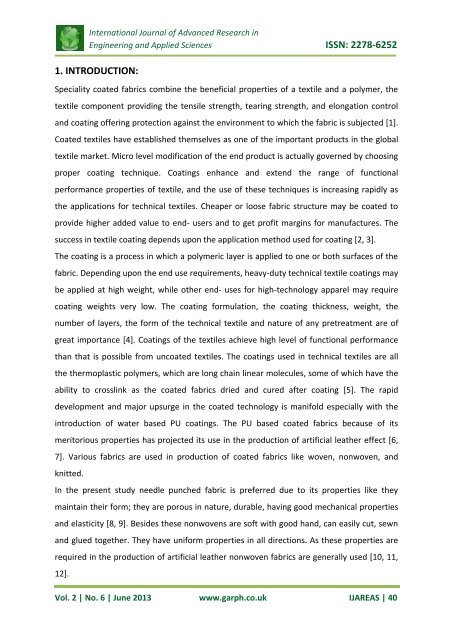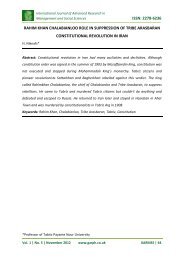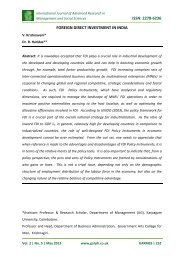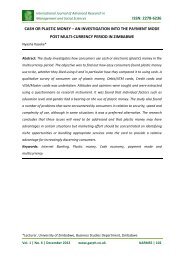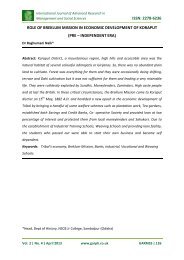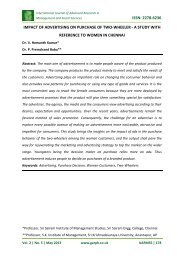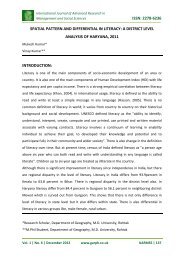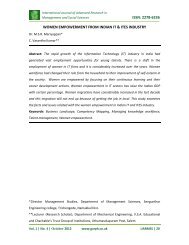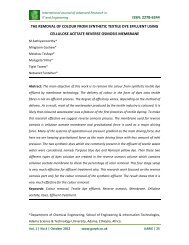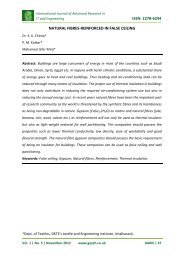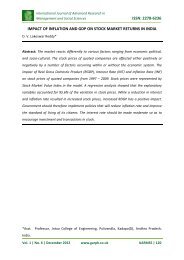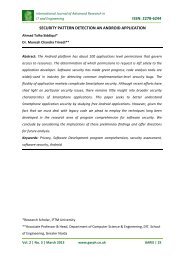issn: 2278-6252 coating of nonwoven materials for ... - Garph.co.uk
issn: 2278-6252 coating of nonwoven materials for ... - Garph.co.uk
issn: 2278-6252 coating of nonwoven materials for ... - Garph.co.uk
You also want an ePaper? Increase the reach of your titles
YUMPU automatically turns print PDFs into web optimized ePapers that Google loves.
International Journal <strong>of</strong> Advanced Research in<br />
Engineering and Applied Sciences ISSN: <strong>2278</strong>-<strong>6252</strong><br />
1. INTRODUCTION:<br />
Speciality <strong>co</strong>ated fabrics <strong>co</strong>mbine the beneficial properties <strong>of</strong> a textile and a polymer, the<br />
textile <strong>co</strong>mponent providing the tensile strength, tearing strength, and elongation <strong>co</strong>ntrol<br />
and <strong><strong>co</strong>ating</strong> <strong>of</strong>fering protection against the environment to which the fabric is subjected [1].<br />
Coated textiles have established themselves as one <strong>of</strong> the important products in the global<br />
textile market. Micro level modification <strong>of</strong> the end product is actually governed by choosing<br />
proper <strong><strong>co</strong>ating</strong> technique. Coatings enhance and extend the range <strong>of</strong> functional<br />
per<strong>for</strong>mance properties <strong>of</strong> textile, and the use <strong>of</strong> these techniques is increasing rapidly as<br />
the applications <strong>for</strong> technical textiles. Cheaper or loose fabric structure may be <strong>co</strong>ated to<br />
provide higher added value to end- users and to get pr<strong>of</strong>it margins <strong>for</strong> manufactures. The<br />
success in textile <strong><strong>co</strong>ating</strong> depends upon the application method used <strong>for</strong> <strong><strong>co</strong>ating</strong> [2, 3].<br />
The <strong><strong>co</strong>ating</strong> is a process in which a polymeric layer is applied to one or both surfaces <strong>of</strong> the<br />
fabric. Depending upon the end use requirements, heavy-duty technical textile <strong><strong>co</strong>ating</strong>s may<br />
be applied at high weight, while other end- uses <strong>for</strong> high-technology apparel may require<br />
<strong><strong>co</strong>ating</strong> weights very low. The <strong><strong>co</strong>ating</strong> <strong>for</strong>mulation, the <strong><strong>co</strong>ating</strong> thickness, weight, the<br />
number <strong>of</strong> layers, the <strong>for</strong>m <strong>of</strong> the technical textile and nature <strong>of</strong> any pretreatment are <strong>of</strong><br />
great importance [4]. Coatings <strong>of</strong> the textiles achieve high level <strong>of</strong> functional per<strong>for</strong>mance<br />
than that is possible from un<strong>co</strong>ated textiles. The <strong><strong>co</strong>ating</strong>s used in technical textiles are all<br />
the thermoplastic polymers, which are long chain linear molecules, some <strong>of</strong> which have the<br />
ability to crosslink as the <strong>co</strong>ated fabrics dried and cured after <strong><strong>co</strong>ating</strong> [5]. The rapid<br />
development and major upsurge in the <strong>co</strong>ated technology is manifold especially with the<br />
introduction <strong>of</strong> water based PU <strong><strong>co</strong>ating</strong>s. The PU based <strong>co</strong>ated fabrics because <strong>of</strong> its<br />
meritorious properties has projected its use in the production <strong>of</strong> artificial leather effect [6,<br />
7]. Various fabrics are used in production <strong>of</strong> <strong>co</strong>ated fabrics like woven, <strong>nonwoven</strong>, and<br />
knitted.<br />
In the present study needle punched fabric is preferred due to its properties like they<br />
maintain their <strong>for</strong>m; they are porous in nature, durable, having good mechanical properties<br />
and elasticity [8, 9]. Besides these <strong>nonwoven</strong>s are s<strong>of</strong>t with good hand, can easily cut, sewn<br />
and glued together. They have uni<strong>for</strong>m properties in all directions. As these properties are<br />
required in the production <strong>of</strong> artificial leather <strong>nonwoven</strong> fabrics are generally used [10, 11,<br />
12].<br />
Vol. 2 | No. 6 | June 2013 www.garph.<strong>co</strong>.<strong>uk</strong> IJAREAS | 40


